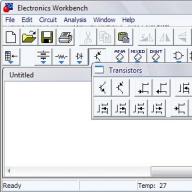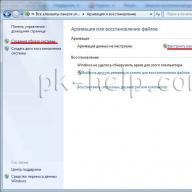Radio amateurs nowadays often use symmetrical trap dipoles for 160-80-40 meters. Antennas of this type have only one advantage - their radiation patterns coincide at different ranges. The disadvantages of this type of antennas include a rather large manufacturing complexity, increased weight, large windage, a narrow band in the lower ranges and not the most outstanding SWR indicators.
In addition, there are multi-band antennas that are quite interesting for radio amateurs - asymmetrical dipoles. Their main disadvantage is that usually, at the lowest frequency range, the maximum of the radiation pattern is deflected by 90 degrees relative to the maxima in other ranges. This is often inconvenient, and such antennas are discarded.
By combining these 2 types of antennas, I managed to create a rather interesting hybrid - asymmetrical trap dipole... It has radiation patterns similar to those of conventional trap dipoles, but its production requires half the number of circuits, which means that all the disadvantages are significantly reduced. trap antennas.
Antenna sketch for 160, 80 and 40 meters is shown in Figure 1. Dimensions are for a suspension height of 15 meters, in brackets for a height of 30 meters.
It is worth dwelling in more detail on the principle of operation of this antenna. The left side of the antenna operates on the 40-meter range, up to the loop tuned to 7.05 MHz. In this range, the antenna is an unbalanced dipole with an aspect ratio of 1: 2. In the range of 80 meters, a piece of wire located between the ladders is connected to it, a dipole is also obtained with an aspect ratio close to 1: 2, but the leftmost wire becomes already the smaller arm of the dipole. In the range of 160 meters, the entire antenna web works, the aspect ratio of the dipole is already significantly different from the ratio at higher ranges, but in this range the antenna is slightly shortened due to the inductances of the ladders, moreover, it is at a relatively low height, all this somewhat reduces it input impedance. As a result, VSWR minimums in ranges no higher than 1.25.
The input impedance of the antenna on all ranges is close to 110 Ohms, so the antenna can easily be powered by a 50-ohm coaxial cable using a transformer on 2 ferrite tubes with a transformation ratio of 1: 2.56, the primary winding (the one connected to the antenna) should contain 5 (2 2.5) turns and the secondary 3 turns. If necessary, these tubes are easily ripped out of Chinese VGA extension cords, which will not be a problem to find.
In this type of antennas, in no case should autotransformers, described in sufficient detail and often found in the literature, be used; they will not provide cut-off of currents on the outer side of the coaxial cable. This, in turn, will cause interference with household equipment, and what is most unpleasant - interference with neighbors' TVs. It is also useful for this type of antennas to install another barrier choke at some distance from the antenna, say, at the entrance of the feeder to the building.
It is also necessary for the static charge to drain from the antenna to install a resistor with a resistance greater than 100 kΩ (its exact resistance is not important) between the cable sheath and the antenna web, it is better to do this from the midpoint of the primary winding of the transformer. The cable sheath should be grounded at the bottom.
Traps are easiest to make from coaxial cable, the trap-rus program will help in their calculations, I would recommend using RK-75-4-12, a flexible and inexpensive cable that allows you to supply more than a kilowatt of power to the antenna. Do not use cables with a foamed dielectric. Dmitry, RV9CX has photos of such ladders, you don't just need to unsolder the ladder according to his scheme. I think everyone knows how to set up ladders.
If you are going to make this antenna from a non-unwoven vole, then a shortening factor of about 2.8% must be taken into account.
Figure 2 - directional patterns.
Figure 2 shows the antenna radiation patterns for a suspension height of 30 meters (9-storey building.) A slight distortion of the antenna pattern is caused by the asymmetry of the antenna coupled with incomplete blocking of the current by ladders, there is nothing terrible in this, nearby objects affect the BP more ...
Tuning the antenna should also not cause any difficulties, in the range of 40 meters it is adjusted by proportional change in the lengths of the 2 left canvases (up to the ladder at 7 MHz). In the range of 80 meters, it is adjusted by the length of the canvas lying between the ramps, and in the range of 160 meters, it is adjusted by the length of the far right canvas (relative to Figure 1).
Figure 3 is a dual band antenna.
Similarly, you can create 2-band antennas, for example, Figure 3 shows a dipole for 160 and 80 meters with one trap. The dimensions are indicated for a suspension height of 15 meters (5-storey building), the antenna can be powered by a coaxial cable with a characteristic impedance of both 50 and 75 ohms. Since the antenna is unbalanced, do not forget about blocking the current on the outside of the braid, a few turns of the cable at the power point on the ferrite ring, or, say, the core from the line transformer of the TV will be enough. The only thing, with a higher suspension height, it may be necessary to increase the input impedance of the antenna, and the antenna matching will have to be done by analogy with the previous antenna.
Roman Sergeev (RA9QCE).
Amateur radio antennas
Antennas for a range of 160 m
"Tell me what's on your roof and I'll tell you who you are!"
And indeed: what kind of antenna the shortwave selected, how he tuned and coordinated it, determines, as a rule, the overall "efficiency" of the radio station, its "range".
The greatest difficulties for radio amateurs are the creation of antenna systems for the low-frequency HF bands, and especially for the 160 m range. Indeed, for the antenna to work effectively, the length of its radiating part must be comparable to the wavelength. For a range of 160 m, this means that the emitter must have a length of at least 30 ... 40 m. And it should be removed from the "ground", in particular from the metal roof of the building, at about the same distance.
It is usually not possible to fully fulfill these requirements, therefore radio amateurs are forced to look for compromise solutions, for example, to deliberately reduce the efficiency of the antenna system, if only its installation is realistic in the specific conditions of the house where the shortwave lives.
For the 160 m range, symmetrical antennas such as a half-wave dipole or various modifications of frames with a wavelength perimeter ( "Square", "Delta Loop" ). In practice, such antennas can be installed only between houses, and in this case the average height of their suspension should be at least 20 ... 30 m. effective for long-distance communications.
Length l (in mm) of the radiating part of the half-wave dipole (fig. 1) calculated by the formula:
l = 142.5 / f.
f is the resonant (operating) frequency of the antenna in MHz. If it is supposed to work both by telephone and telegraph, then the resonant frequency of the antenna should be chosen close to the middle of the range (for example, 1.9 MHz). If the work will be carried out mainly with only one type of radiation, then it is advisable to choose it close to the middle of the corresponding section of the amateur band.


Fig. 1. Balanced antenna half-wave dipole
It should be noted that in practice, the length of the emitter may differ significantly from the calculated one due to the influence of surrounding objects. That is why, when making an antenna, the initial length of the radiator must be taken with a certain margin, and then, during the tuning process, it must be specified.
The input impedance of the dipole is about 75 ohms, so a coaxial cable with a characteristic impedance of 75 ohms should be used to power it. However, a 50-ohm cable can be used here. Firstly, it is very likely that the input impedance of the dipole at real heights of the suspension will be below 75 Ohm, and secondly, such a slight mismatch between the antenna and the feeder (VSWR up to 2) practically does not affect its efficiency.
The emitter itself is made of a copper cable with a diameter of 2 ... 3 mm. In order to exclude a break in the coaxial cable at the point of its connection to the emitter, cable 5 must be rigidly attached (for example, with U-shaped clamps) to the T-shaped insulator 4, which is made of PCB with a thickness of at least 3 mm. The part of the insulator, which works in tension, is reinforced with a textolite bar 6 with dimensions of 15x25x100 mm. The braid and the central core of the coaxial cable are soldered to the arms 2 and 3 of the radiator.
Tune the antenna based on the SWR measurements in the frequency band. From these measurements, the resonant frequency of the antenna is found, i.e. the frequency at which the SWR is minimal. If it is less (more) than the given one, then the dipole is shortened (lengthened). The amount by which it is necessary to shorten or lengthen each of the arms of the dipole is determined by the formula:

Here f2 is the frequency to which the antenna should be tuned, and l` and f1 are, respectively, the initial length of the dipole and its resonant frequency.
In real conditions, the arms of the dipole can be set at a certain angle, somewhat less than 180 degrees, and even bend each of the arms (fig. 2).

Fig. 2. Half-wave dipole antenna with curved shoulders
In this case, the input impedance of the antenna is somewhat reduced; therefore, it is advisable to connect such antennas with a 50 Ohm coaxial cable. The directional diagram will also change, which for a classical dipole looks like a "figure eight". Tuning this antenna is a little more difficult, as the influence of objects around it is usually stronger. In order not to "skip" the resonant frequency, the arms of the dipole should be shortened here gradually, step by step. This option for installing the dipole is, of course, a compromise, but it allows, with a slight decrease in the efficiency of the antenna, to "tie" it to specific local conditions.
The length of the radiating part of the dipole can be almost halved by introducing an "extension" coil into each of its arms (fig. 3).

Fig. 3. Half-wave dipole antenna with extension coils
In order not to significantly reduce the efficiency of the antenna, the "extension" coils should have low intrinsic losses, i.e. high (about 150) quality factor. In addition, they must be reliably protected from atmospheric moisture.
This antenna is powered by a 50 ohm coaxial cable. When indicated on fig. 3 the dimensions of the radiating part, the coils L1 and L2 should have an inductance of about 70 μH. They can be made on frames with a diameter of 40 mm and a length of 80 mm, onto which 65 turns of PEV-2 wire with a diameter of 1.2 mm are wound (ordinary winding, turn to turn). If the radio amateur has other frames at his disposal, then the required number of turns can be estimated by the formula:

Here L is the inductance of the coil in μH; D and l - diameter and length of the coil in cm; n is the number of turns. Since the winding is ordinary, then l = nd, where d is the diameter of the coil wire in cm. The required resonant frequency of the antenna is set by choosing the length of the outer (14-meter) segments of each arm.
A shortened dipole can be easily installed on the roof of one building, modifying it into an antenna of the type "Inverted V" (she is shown in fig. 3 ). To install such an antenna, only one mast with a height of about 15 m is required. The arms of the dipole simultaneously perform the functions of two (out of the required four) guys for fastening the mast. As already noted, at such a suspension height, the dipole emits mainly at large angles to the horizon. However, even taking into account this disadvantage, the described shortened antenna IV may be more effective than single-ended antennas, which will be discussed below.
The disadvantage of all single-ended antennas (these include a variety of "wire" type antennas "Long Wire" , as well as vertical emitters of the type "Ground Plane" ) is the need to have a good "land", i.e. grounding (in the radio engineering sense of the word). It is almost impossible to implement good grounding in cities, so a radio amateur, if he decides (or is forced by circumstances) to install an antenna with an unbalanced power supply, must take care of good counterweights.
The input impedance of most single-ended antennas lies in the range of 10 ... 30 Ohm, and for shortened antennas it can be a few Ohms or even a fraction of Ohm. Meanwhile, the loss resistance for a common system of three counterweights at an angle of 120 degrees to each other is approximately 30 ohms. Thus, when using counterweights, more than half of the power delivered by the transmitter is wasted. For an asymmetrical antenna to work effectively, the number of counterweights should be 10 ... 12, and it is not at all necessary that they all have a quarter wavelength (Figure 4a).

Fig.4a. Placement of counterweights in a circle
The fact is that the highest value of the HF current density is directly at the base of the antenna, it is here that you must have the largest total cross-section of the counterweight conductors. If the counterweights cannot be installed in a circle (which is usually the case), then they should be placed as shown in Fig. 4b.

Fig.4b. Counterweight placement is uneven
On the fig. 5 there are two variants of the L-shaped antenna for the 160 m range. Power is supplied to both antennas using a coaxial cable with a characteristic impedance of 50 ohms. The ratio between the lengths of segments A and B can be chosen arbitrarily, it is only important that their total length is 38 m for option a and 43 m for option b.

Fig.5a. L-shaped antenna with an input impedance of 10 ohms
Antenna on fig. 5a
with a segment length of A = 10 m, it has an input impedance of about 10 ohms. Coil L1 has an inductance of 13 μH. It is made on a frame with a diameter of 50 mm and contains 20 turns of bare copper wire with a diameter of 0.8 ... 1.0 mm. Winding length 50 mm. With a transmitter power of up to 10 W, a capacitor bank from a tube broadcasting receiver can be used as a capacitor C. The antenna is tuned first with a capacitor C, achieving consistent resonance at the operating frequency (set at the maximum load of the transmitter antenna). After that, select the position of the tap on the coil L1 at the minimum SWR.
Antenna shown on fig. 5b
, has an active component of the input resistance of about 50 Ohm, if the length of the segment A = 10 m.

Fig. 5b. L-shaped antenna with 50 ohm input impedance
When setting up this antenna, first compensate with a capacitor C for the reactive component of the input resistance (it has an inductive character), and then select the antenna length to minimize the SWR, each time adjusting the capacitor C. Due to the large input impedance, this antenna works more efficiently than the one shown in fig. 5a , but the latter is easier to set up, since it does not require a careful selection of the total antenna length.
In a particular case, either of these two antennas can start directly at the transmitter and pass through a window frame to the nearest house or some tree. Under these conditions, it is practically impossible to create a branched system of counterweights, therefore the transmitter housing must be connected with short conductors to the water supply pipes, heating pipes and to the balcony fittings (if the house is made of reinforced concrete). In addition, such a "grounding" system should be supplemented with at least one counterweight of the maximum possible length (but not less than 5 m). This counterweight can be stretched on the outside of the balcony or along the wall of the house. It is connected to the transmitter body through a coil (fig. 6) , the inductance of which should be established experimentally by the minimum value of the RF voltage on the transmitter housing (the initial value of the inductance is 200 μH).

Fig. 6. Counterweight connection
This voltage can be recorded with the simplest HF voltmeter. (fig. 7) , which is connected to the body with only one terminal.

Fig. 7. Measuring RF voltage at the transmitter housing
If the radio amateur has the ability to make a good counterbalance system, then for long-distance communications, it is still better to install a shortened, but vertical, GP type antenna. Quite decent results can be obtained with antennas up to 15 m high.
One of the options for such an antenna is shown in fig. 8. It consists of a vertical radiator (mast) 12 m long, isolated from the ground at the base. The emitter is a metal tube. It has a so-called upper capacitive load, which is formed by four wires 15 m long. The angle between these wires (they simultaneously play the role of guy wires) and the pipe must be 90 degrees. Power is supplied to the antenna using a coaxial cable with a characteristic impedance of 50 ohms. With a small length of the feeder, it is advisable not to install any matching elements at the base of the antenna (in this case, there is no need to seal them), but to work with a standing wave in the cable. In this case, it is imperative that the transmitter has a separate antenna matching unit at the radio station, since the possibilities for matching at its output circuit (usually a P-filter) may not be enough.

Fig. 8. GP type vertical antenna
Antenna shown on fig. 9 , has a total height of about 13.5 m. The shortening in it is achieved due to the inclusion of the "shortening" coil L1, similar to how it was done in the shortened dipole, which was described earlier. This coil should have an inductance of about 160 μH. It is wound with a bare copper wire with a diameter of 70 mm. It has 90 turns. The length of the winding is 220 mm, and the total length of the insert into the pipe is 300 mm. The inductance of the matching coil L2 is about 10 μH (20 turns of the same wire wound on a frame with a diameter of 40 mm, winding length 50 mm).

Fig. 9. Antenna with "shortening" coil
This antenna is tuned to the operating frequency using a heterodyne resonance indicator (by choosing the length of the upper section of the antenna and, if this is not enough, by choosing the number of turns of the coil L1). Then, according to the minimum SWR, the position of the tap on the L2 coil is selected. Like all other shortened radiators, this antenna is narrowband, it should be tuned to that part of the range where work is most often carried out.
With the difficulties associated with the installation of antennas, one can only dream of directional transmitting antennas for the low bands, and especially for the 160 m band. But for reception, such antennas are relatively easy to implement. Usually they are frames, consisting of one or more turns. Loop antennas have two distinct minima when receiving a signal, directed perpendicular to its plane. Suppression of signals from these directions can reach about 30 dB (five points on the S scale!). This makes it possible to "remove" interference: signals from another amateur station, harmonics from a medium-wave broadcast radio station, etc.
A possible embodiment of a loop antenna is shown in fig. 10.

Fig. 10. Loop antenna
It consists of three turns (in the form of a square with a side of 1.5 m), forming the actual frame, and one turn of communication. The diameter and brand of the wire are not critical, in particular, an ordinary installation wire will do. The frame is placed in an electrostatic shield, open at the top. The screen can be made of a coaxial cable braid, and in general, the frame can be fixed on a wooden cross-piece. The frame is tuned to the operating frequency by the capacitor C, which must be reliably protected from atmospheric moisture. The frame is connected to the receiver using a coaxial cable with a characteristic impedance of 50 Ohm.
"Radio Yearbook" 1983
Comments on the article:
| Added by: Sergey | |
|
|
| Date: 2012-07-23 |
| Added by: Sergey |
| Date: 2012-01-07 |












